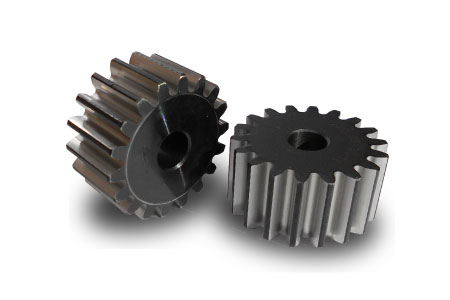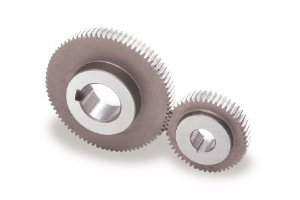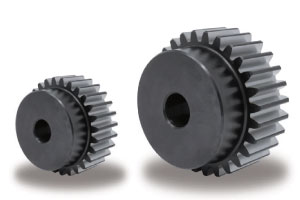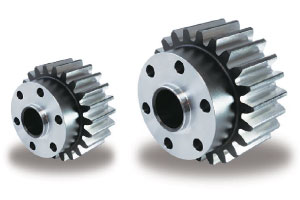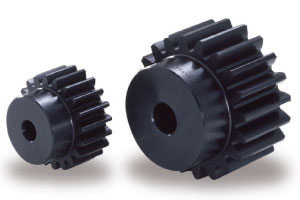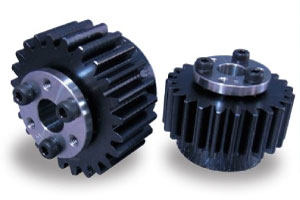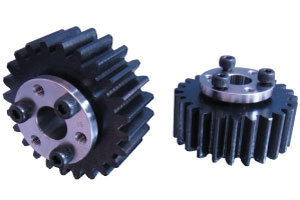What is a spur gear ?

Spur gears are the most easily visualized common gears that transmit motion between two parallel shafts. Because of their shape, they are classified as a type of cylindrical gears. Since the tooth surfaces of the gears are parallel to the axes of the mounted shafts, there is no thrust force generated in the axial direction. Also, because of the ease of production, these gears can be made to a high degree of precision. On the other hand, spur gears have a disadvantage in that they easily make noise. Generally speaking, when two spur gears are in mesh, the gear with more teeth is called the “gear” and the one with the smaller number of teeth is called the “pinion”.
The unit to indicate the sizes of spur gears is commonly stated, as specified by ISO, to be “module”. In recent years, it is usual to set the pressure angle to 20 degrees. In commercial machinery, it is most common to use a portion of an involute curve as the tooth profile.
Even though not limited to spur gears, profile shifted gears are used when it is necessary to adjust the center distance slightly or to strengthen the gear teeth. They are produced by adjusting the distance between the gear cutting tool called the hobbing tool and the gear in the production stage. When the shift is positive, the bending strength of the gear increases, while a negative shift slightly reduces the center distance. The backlash is the play between the teeth when two gears are meshed and is needed for the smooth rotation of gears. When the backlash is too large, it leads to increased vibration and noise while the backlash that is too small leads to tooth failure due to the lack of lubrication.
All KHK spur gears have an involute tooth shape. In other words, they are involute gears using part of the involute curve as their tooth forms. Looking generally, the involute shape is the most wide-spread gear tooth form due to, among other reasons, the ability to absorb small center distance errors, easily made production tools simplify manufacturing, thick roots of the teeth make it strong, etc. Tooth shape is often described as a specification in drawing of a spur gear as indicated by the height of teeth. In addition to standard full depth teeth, extended addendum and stub tooth profiles exist.
With this technical data you can view comprehensive information regarding KHK spur gears such as their features and advice and warnings when selecting and using them.
SSDP
DP Steel Spur Gears
DP : 4 – 12
Material : S45C (AISI/SAE 1045)
Hardening : None
Tooth finish : Cut (non-ground)
Grade : JIS N8 (equiv.to AGMA 8,9)
Spur Gears with inch based DP tooth pitch
Click Here to Select Spur GearsMSGA / MSGB
Ground Spur Gears
Module : 1 – 4
Material : SCM415
Hardening : Overall Carburizing
Tooth finish : Ground teeth
Grade : JIS N5
Fully hardened, ground and keyway machined gears with excellent accuracy, strength and abrasion resistance.
Click Here to Select Spur GearsKSG
Ground Spur Gears
Module : 1 – 3
Material : SCM440
Hardening : Thermal refined, gear teeth induction hardened
Tooth finish : Ground teeth
Grade : JIS N6 (Please see details on PDF)
Gears that have been tempered, hardened and ground that have excellent accuracy, strength and abrasion resistance. Secondary operations can be performed except for the teeth. This product is ideal for the pinion of the KRGF rack.
Click Here to Select Spur GearsSSGS
Ground Spur Pinion Shafts
Module : 1.5 – 3
Material : S45C
Hardening : Thermal refined, gear teeth induction hardened
Tooth finish : Ground teeth
Grade : JIS N7
Gears with shafts that have been tempered, hardened and ground. Secondary operations can be performed except for the teeth.
Click Here to Select Spur GearsSSG
Ground Spur Gears
Module : 0.5 – 10
Material : S45C (Please see details on PDF)
Hardening : Gear teeth induction hardened NOTE 1 (Please see details on PDF)
Tooth finish : Ground teeth
Grade : JIS N7 (Please see details on PDF)
Gears that have been hardened and ground with a good balance of accuracy, wear resistance and cost. Secondary operations are possible except for the teeth.
Click Here to Select Spur GearsSSG-F
Ground Spur Gears
Module : 2 – 3
Material : S45C (SCM435)
Hardening : Gear teeth induction hardened
Tooth finish : Ground teeth
Grade : JIS N7 equivalent
No rattling of shaft and gear when fastening
Click Here to Select Spur GearsSSG-E
Ground Spur Gears
Module : 1.5 – 6
Material : S45C (SCM435/SCM420)
Hardening : Gear teeth induction hardened
Tooth finish : Ground teeth
Grade : JIS N7 equivalent
- Can be easily installed with one bolt (shortens work time)
- Concentricity 0. 02mm
- Zero backlash between the gear and shaft
SSG-R
Ground Spur Gears
Module : 1.5 – 6
Material : S45C
Hardening : Gear teeth induction hardened
Tooth finish : Ground teeth
Grade : JIS N7 equivalent
Products matching the mounting holes of the corresponding speed reducer series
Click Here to Select Spur GearsR series for GH
Pinion for Nabtesco GH
Module : 3 - 6 / CP : 10 - 20
Material : S45C / SCM440
Hardening : Gear teeth induction hardened (Thermal refined, gear teeth induction hardened)
Tooth finish : Ground teeth
Grade : JIS N7 / N6 equivalent
Perfect for Nabtesco Corporation’s GH Series
Click Here to Select Spur GearsSSAG
Ground Hubless Spur Gears
Module : 1 – 6
Material : S45C
Hardening : Gear teeth induction hardened NOTE 1
Tooth finish : Ground teeth
Grade : JIS N7 (Please see details on PDF)
Gears that have been hardened and ground with a good balance of accuracy, wear resistance and cost. Secondary operations are possible except for the teeth.
Click Here to Select Spur GearsKS-H
Hardened Spur Gears
Module : 1.5 – 5
Material : SCM440
Hardening : Thermal refined, gear teeth induction hardened
Tooth finish : Cut (non-ground)
KS + "Hardened Plus"
Click Here to Select Spur GearsKS
Thermal Refined Spur Gears
Module : 1.5 – 5
Material : SCM440
Hardening : Thermal Refined only
Tooth finish : Cut (non-ground)
Grade : JIS N8 (Please see details on PDF)
Tempered gears with excellent bending strength. The teeth can be additionally hardened. This product is ideal for the pinion of the KRF rack.
Click Here to Select Spur GearsSSS
Spur Pinion Shafts
Module : 1, 1.5
Material : S45C (Please see details on PDF)
Hardening : Thermal refined NOTE 2 (Please see details on PDF)
Tooth finish : Cut (non-ground)
Grade : JIS N8 NOTE 3
Gears with a tempered shaft.
Click Here to Select Spur GearsSS
Steel Spur Gears
Module : 0.5 – 10
Material : S45C
Hardening : None
Tooth finish : Cut (non-ground)
Grade : JIS N8 NOTE 3 (Please see details on PDF)
Many lineups are available at a low price. The teeth can be additionally hardened.
Click Here to Select Spur GearsSS-F
Steel Spur Gears
Module : 1.5 – 3
Material : S45C (SCM435)
Hardening : None
Tooth finish : Cut (non-ground)
Grade : JIS N8 equivalent
No rattling of shaft and gear when fastening
Click Here to Select Spur GearsSSA
Steel Hubless Spur Gears
Module : 1 – 5
Material : S45C
Hardening : None
Tooth finish : Cut (non-ground)
Grade : JIS N8 NOTE 3 (Please see details on PDF)
Many lineups are available at a low price. The teeth can be additionally hardened.
Click Here to Select Spur GearsSSA-F
Steel Spur Gears
Module : 2 - 3
Material : S45C (SCM435)
Hardening : None
Tooth finish : Cut (non-ground)
Grade : JIS N8 equivalent
No rattling of shaft and gear when fastening
Click Here to Select Spur GearsSSY
Steel Thin Face Spur Gears
Module : 0.8, 1
Material : S45C
Hardening : None
Tooth finish : Cut (non-ground)
Grade : JIS N8 NOTE 3 (Please see details on PDF)
Gears with narrow teeth. Suitable for light loads.
Click Here to Select Spur GearsSSAY
Steel Hubless Thin Face Spur Gears
Module : 1
Material : S45C
Hardening : None
Tooth finish : Cut (non-ground)
Grade : JIS N8 NOTE 3
Gears with narrow teeth. Suitable for light loads.
Click Here to Select Spur GearsSUS / SUSA
Stainless Steel Spur Gears
Module : 1 – 4
Material : SUS303
Hardening : None
Tooth finish : Cut (non-ground)
Grade : JIS N8 (Please see details on PDF)
Stainless steel gears with rust resistance.
Click Here to Select Spur GearsSUSF
Stainless Steel F-Loc Gears
Module : 0.5 – 1
Material : SUS303
Hardening : None
Tooth finish : Cut (non-ground)
Grade : JIS N8 NOTE 3 (Please see details on PDF)
Stainless steel gears with rust resistance. Locking Hub allows easy attachment.
Click Here to Select Spur GearsDSF
Acetal F-Loc Gears
Module : 0.5 – 1
Material : Polyacetal/SUS303
Hardening : None
Tooth finish : Cut (non-ground)
Grade : JIS N10 NOTE 3 (Please see details on PDF)
Gears made of polyacetal. Locking Hub allows easy attachment.
Click Here to Select Spur GearsNSU
Plastic Spur Gears with Steel Core
Module : 1 – 3
Material : MC602ST/S45C
Hardening : None
Tooth finish : Cut (non-ground)
Grade : JIS N9 (Please see details on PDF)
Steel hubs are fused and fixed to reinforced nylon gears for secure fastening.
Click Here to Select Spur GearsPU
Plastic Spur Gears with Steel Core
Module : 1 – 2
Material : MC901/SUS303
Hardening : None
Tooth finish : Cut (non-ground)
Grade : JIS N9 (Please see details on PDF)
Stainless steel hubs are fused and fixed to nylon gears for secure fastening.
Click Here to Select Spur GearsPS / PSA
Plastic Spur Gears
Module : 1 – 3
Material : MC901
Hardening : None
Tooth finish : Cut (non-ground)
Grade : JIS N9 equivalent
Nylon gears can be used with no lubrication.
Click Here to Select Spur GearsPSUKB
SUKB Assembled PSA Spur Gear
DS
Injection Molded Spur Gears
Module : 0.5 – 1
Material : Duracon (R) (M90-44) NOTE 4
Hardening : None
Tooth finish : Injection molded
Grade : Equiv.to JIS N12 (Please see details on PDF)
Low-priced gears made through injection molding. Suitable for light loads.
Click Here to Select Spur GearsBSS
Brass Spur Gears
Module : 0.5 – 1
Material : C3604
Hardening : None
Tooth finish : Cut (non-ground)
Grade : JIS N8 NOTE 3 (Please see details on PDF)
Brass gears with excellent machinability.
Click Here to Select Spur GearsSSR
Steel Ring Gears (Spur Gears)
Module : 2 – 3
Material : S45C
Hardening : None
Tooth finish : Cut (non-ground)
Grade : JIS N9
They have a ring shape with a large number of teeth.
Click Here to Select Spur Gears
[NOTE 1] Products with module under 1 are thermal refined. Gear teeth are not hardened.
[NOTE 2] SA-shaped products with module 1 have no material thermal refinement treatment.
[NOTE 3] The product accuracy class having a module under 1 corresponds to 'equivalent' as shown in the table.
[NOTE 4] "Duracon (R)" is a registered trademark of Polyplastics Co., Ltd. in Japan as well as other countries.
Gear Module
Simply said, the gear terminology “module” refers to the gear tooth size. Larger tooth size enables more power to be transmitted, and it should of course be obvious that the mating gears must have the same module.
Supposing the case of spur gears, we would like to explain the technical aspects more precisely. As stated before, module is one type of units of tooth size measure, and multiplying a gear’s module by pi (π) yields the gear’s pitch. (Incidentally, in the context of screws and gears, the pitch is the distance between the consecutive threads and teeth.) Also, module is defined as the pitch diameter divided by the number of teeth, and the distance from the pitch circle to the outside circle (addendum) is equal to the module in spur gears.
In addition to module to indicate the tooth size, there are CP (circular pitch) used mainly to insure accurate positioning, DP (diametral pitch) in an inch based system, etc., but the most used unit internationally is module, and even in the US where DP is mostly used, the module based gears which are called metric gears are becoming more widespread. The units used in standardized gears are mostly module or DP, and at KHK they are also standardized but generally not too many standard CP gears are seen. Also, in module and CP units, as the values go up, the tooth size increases; but in DP unit, as the value increases, the tooth size become smaller.
In general gear technical papers and supplier provided gear related technical data, the explanations of these contents typically use spur gears as examples due to its simplicity and ease of understanding. We at KHK offer further explanation using spur gears on our website, and we urge you to refer to them.
Related links :
Gear Module – A detailed description of gear module
Metric Gears with pitch unit of module
Metric gears are used in many countries and areas where the main unit of measure is the metric system. The size of gear teeth is expressed by its pitch called module unit. On the other hand, countries such as US where the length unit is measured in inch, the unit of measure for gear pitch is usually in DP (diametral pitch).
The use of module as the gear pitch unit is specified by ISO. In many cases, module is the PCD (pitch circle diameter) divided by the number of teeth so that as the gear teeth get larger the module value goes up.
Besides module as the measure of tooth size, there are previously mentioned DP and CP (circular pitch). When CP is used and a pinion rotates once, the distance moved becomes an integer (mm) and is convenient in positioning in linear motion. Depending on the unit, whether module, DP or CP, a different hobbing tool is required.
The stock gears supplied by KHK are, with exception of CP gears, mostly module based metric gears and are widely used all over the world. On the other hand, KHK can also produce custom gears in module , CP and DP gears.
The following link will lead to the comparison of these pitches :
Table of Comparative Gear Pitch
Stainless Steel Spur Gears
For gear materials, SUS303 and SUS304 are most widely used. SUS304 is the most used stainless steel, but SUS303 has higher machinability.
Including SUS303 and SUS304, the following materials for stainless steel spur gears are generally used.
Austenite group stainless steel
SUS303, SUS304, SUS403
For heat treating, nitriding is used, but because the nitrided surface is shallow, tooth grinding is not doable.
Martensite group stainless steel
SUS420J, SUS440C, SUS403
For heat treating, tooth surface induction hardening is used, and tooth grinding is often performed following hardening.
Precipitation hardened group stainless steel
SUS630, SUS631
For heat treating, precipitation hardening is used, and tooth grinding is often used after hardening.
The anti-rust property is the characteristic of stainless steel spur gears. Therefore, their use is suitable where rust is unwanted such as in food, chemical and pharmaceutical machines.For example, if a pair of spur gears are made from a common plastic material, the gears tend to store heat, and the thermal expansion causes dimensional change resulting in reduction of backlash, so that if a plastic material is used for one side, it is recommended that a stainless is used for the other mating gear.
Types of KHK Stainless Steel Spur Gears :
SUS, SUSA, SUSL
Ground Spur Gears superior in quietness
Ground spur gears have gear surfaces ground using a gear grinder in order to achieve high precision and improve surface finish. Some of the reasons for using ground gears are improving noise and vibration, increasing torque transmission capacity, use in high rotational speed applications, etc.
In order to manufacture high strength and high precision gears, the deformation of tooth surface due to heat treating is normally corrected with teeth grinding operations. Also, to further improve precision of ground gears, in addition to teeth grinding, the gears are subjected prior to teeth grinding to grinding of the bore, outside diameter and flat surfaces. On the other hand, another way to improve the gear precision is to do the gear shaving operation prior to hear treating.
In general, since the use of ground gears are for the purpose of lowering noise and vibration, when mating a pair, if the one side is ground gear, a ground gear is used for the other side. But, when there is a difference in the number of teeth, in actual cases, the need for teeth grinding is determined case by case to optimize the balance between cost and strength, for example, by using ground gear only for the smaller gear.
Among the KHK brand of standard gears, there are many ground gears in various categories besides spur gears and we ask you to consider selecting them according to your application needs.
Types of KHK Ground Spur Gears :
MSGA, MSGB, SSGS, SSG
Spur gear catalog
Among the most frequently requested information for each gear in the spur gear catalogs are the following :
- Dimension related data such as pitch diameter, outside diameter, face width, bore size, etc.
- Tooth related information such as number of teeth and pitch (module)
- Allowable torque from bending strength and surface durability
- Precision class, also related to tooth grinding
- Hardness related data with presence or absence of heat treatment and type
- Photograph of the exterior view
- Pricing
Related links :
Gear Catalog – A detailed description of gear catalog
Gear’s Intended Use
First, one of the intended use of gears is to absorb the gap in torque or rotating speed between the prime movers such as motors and engines and the driven mechanisms.
When the prime mover has high rotation while the driven mechanism requires low rotation or when the prime mover generates torque not sufficient for the driven mechanism, the prime mover cannot be directly connected to the driven mechanism. In such cases, a speed reducer is utilized to absorb these gaps. Gears are often used in such speed reducers.
Also, for example, when two parallel rollers are used in rolling apparatus where the rollers turn synchronously, you can think of using servo motors on each roller, but if you can use spur gears, the two can be rotated with one motor using gears. (Because there is only one motor) the synchronization is naturally achieved. In other words, the use of spur gears here contributes to cost reduction while achieving change of rotational direction, synchronization of rollers and reduction in the number of motors.
Also, in mechanism design, gears can contribute to size reduction in the motor used in the application. When a certain speed and torque output is desired :
(1) specify a motor that satisfies the conditions and use it directly
(2) we can think of using a motor with low torque and high speed than those of desired values but obtain the same output
by using gears. If the method in (2) can be used, (since generally, the low torque, high speed motor is compact), it is possible to downsize the motor in this application.
With screw gears and bevel gears, it is possible to produce complex power transmission such as changing the directions of the rotating shafts while reducing speed. For example, in a transport system, by using gears, it is possible to drive many shafts with one motor, allowing possible reduction in over-all cost by decreasing the number of motors.
There are many different intended use of gears beside the above examples, and in any event, needless to say, in transmission of power, it is important to select the best mechanical element suitable for each application.
Related links :
Gear Catalog - A detailed description of KHK’s gear catalog
Types of Gears - A detailed description of Types of Gears
Manufacturing of Spur Gears
The majority of metallic spur gears are made by cutting, but there are other methods such as rolling, casting and forging. On the other hand, for plastic spur gears, besides tooth cutting as with metal gears, injection molding may be used depending on the production quantity.
The production steps for metal spur gears, when high accuracy and hardness are not needed, usually consist of: cutting off round rod material, turning blanks on a lathe, tooth cutting using, for example, a hobbing machine, and deburring. In addition, set screw holes and keyways may be added as needed. Also, as far as the materials for spur gears are concerned, depending on the production lot, applications, etc. round rods and cast materials and others are used.
The tooth forming process can be roughly divided into two kinds as “gear form generating” and “gear form milling” methods. The gear form generating is a widely used method and its use allows mass production of high precision involute gears. In this method, by meshing the cutting tool with the gear blank, the tooth form equal to the pitch of the cutter is generated. As for kinds of cutting tools, they can be classified as method using a hob (cylindrical twisted tooth rotating cutter), method using rack shaped cutter and method using pinion shaped cutter. On the other hand, the gear form milling method consists of using a cutter shaped as the gear groove form attached to a milling machine and cutting one groove of the gear at a time.
After gear cutting, tooth surface grinding and shaving processes are sometimes used to increase accuracy and strength.
Gear grinding is used to improve the accuracy and surface roughness of gears. It indicates the process of grinding the gear tooth surface, after tooth cutting and heat treating, with a polishing stone which is rotating at high speed. It is performed on a special tooth grinding machine. The production process steps for ground gears can be listed, for one example, as cutting off material, blank making using lathe, tooth cutting, deburring, heat treating, side surface grinding, bore grinding, and tooth grinding. On the other hand, shaving means a process used in high rate production of a large quantity of the same gears such as in the automotive industry where it is used after gear cutting to further improve gear accuracy. However, the shaving cutter used in the process lacks versatility, requiring different ones in many cases for each different gear. Ordinarily after shaving, gears are heat treated and finished with honing.
Related links :
Gear Calculator
“Raw Material” and “Gear Precision Grade” Equivalent Tables
直齿轮 – 中文页




